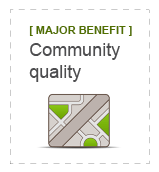Adopt commercial development and design standards for auto-oriented development corridors and clusters.
Frank Douma, Director of State & Local Policy and Outreach of the Institute for Urban and Regional Infrastructure Finance, University of Minnesota: 612/626-9946, douma002@umn.edu, www.hhh.umn.edu/people/fdouma/

- Improved flow of highway traffic, lowered risk of auto crashes.
- Long-term reduction in vehicle miles traveled due to more compact development.
- Less leap-frog development, lowering costs of extending and maintaining infrastructure.
- More synergy for clustered retail businesses.
- More development pressure for infill sites.
- Higher quality, more aesthetic development without "visual pollution," that is sensitive to its context (rural, suburban, town center/urban core) and thus retains its property value.
- Despite these benefits of better auto-oriented development, the retail meltdown of 2015 onward reveals that these large format developments are far more economically fragile than previously anticipated and are vulnerable to growing e-commerce. Unlike rows of interchangeable national chains on the edge of town, a more diverse ecosystem of small locally owned businesses can rapidly respond to consumer need while offering experiences that can’t be replicated through e-commerce. Before cities zone more land for large format development, focused work to support smaller, more accessibile and high-quality retail is a must, along with easing the zoning that often exclusively mandates suburban-style big box and strip-mall developments. These zoning districts often require an ocean of parking and massive setbacks from the road while prohibiting common non-retail uses, including residential, light industrial, and office space.
- A successful approach to large format retail developments was developed in 2008 by the City of Ferndale, WA. Established by ordinance, this three-pronged approach to retail development, including big-box stores, includes a scorecard called EAGLE: Energy efficiency, Advanced technologies, Greater good, Low impact, Economic development.
- The MN Dept. of Transportation lists ten access management principles, which include:
- 5. Avoid strip development. Promote commercial nodes. Commercial development can be located adjacent to and visible from the highway, but should be accessed via a system of parallel local roads and side streets that complement the state highway system requirements.
- The MN Dept. of Transportation has developed mobility performance targets for interregional corridors, which comprise 2,960 miles of highways that represent 2% of all roadway miles in the state and that account for 33% of all vehicle miles traveled in the state.
Optional Best Practice for Step 3 Recognition
Category A, B and C cities: implement this best practice by completing any one action.
Limited-access highway-oriented commercial development is a common land use pattern. In many Minnesota towns a highway transects three distinct contexts: rural, "sub-urban," and the town center, or urban core. The sub-urban or 'at the edge of town' area is the most challenging context and is the focus of this best practice, which also addresses the common "in-town" land use of auto-oriented commercial developments (both commercial arterials and large-format superblocks).
Typical highway commercial development is appropriately oriented towards automobile traffic, but often lacks visual appeal, creates an inefficient linear development pattern rather than clusters, and reduces highway functionality by creating too many closely spaced problem intersections. Auto-oriented development also is typically lower density, consuming development acres less efficiently and yielding lower property tax revenues per acre. This style of development fragments habitat and imposes higher infrastructure maintenance costs onto cites. As gateways into - and the places that visitors get their first impressions of - communities, highway commercial development can be made more context-sensitive, attractive, ecological, efficient and even bikable/walkable.
